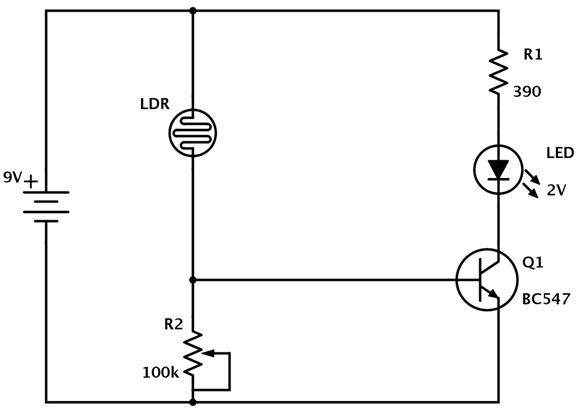Light dependent resistor or photoresistor is a device whose resistance is dependent on the strength of the light as they are composed of high resistance semiconductor material. When light hits the device, the photons give electrons energy. Higher the power of light, lower the strength of resistance. This particular action makes the electron jump into the conductive band and thus conduct electricity. Taking a cue from this concept, Øyvind Nydal Dahl, in this tutorial, has dealt in a circuit for LDR or Light Dependent Resistor to make a light detector.

The above LDR Circuit Diagram works on the amount of light penetration. Hence, when it is completely dark, the LDR occupies high resistance. As a result, the voltage at the base of the transistor becomes too low to turn the transistor ON. At this stage, the current doesn’t flow from the collector to the emitter of the transistor, instead, it passes through the LDR and the potentiometer.
When the light is provided at comparatively low density, the LDR has low resistance. But it is sufficient enough to bring the voltage at the base of the transistor higher and also to turn the transistor ON. Once the transistor is turned on, current starts flowing through it from the positive battery terminal to the negative battery terminal covering R1 and the LED. With this, the LED, lights up.

The equipment required to build the Light Detector Circuit includes resistor and LEDs. The former determines the amount of current that flows through the LED. An LED with 2V voltage drop gives a 7V voltage drop over the resistor when the transistor is ON and in general, 18 mA is considered as good current value for common LEDs.
To power the circuit, a 9V battery is used and if any other battery is used, then the resistor value is changed to get the right amount of current flowing through the LED. To change the trigger point for the LED, the variable resistor R2 is used, which examines the right amount of light for the LED to turn ON and OFF. Depending on the resistance of the LDR, you can use potentiometer accordingly.
The LED can be turned ON when it’s Dark by replacing the NPN transistor with a PNP transistor. For complete details, visit the following link.
Filed Under: Reviews


Questions related to this article?
👉Ask and discuss on EDAboard.com and Electro-Tech-Online.com forums.
Tell Us What You Think!!
You must be logged in to post a comment.